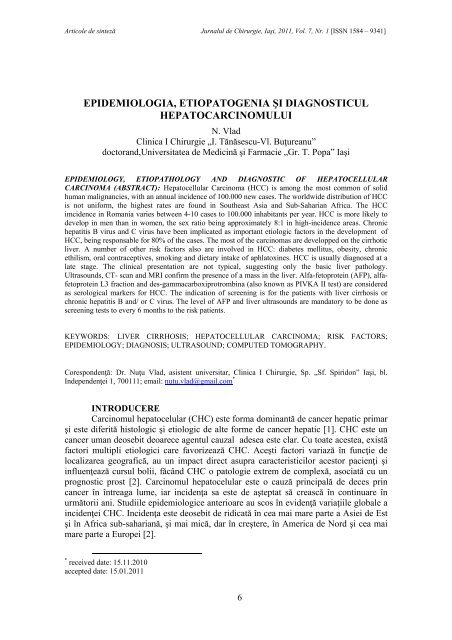You also want an ePaper? Increase the reach of your titles
YUMPU automatically turns print PDFs into web optimized ePapers that Google loves.
Articole <strong>de</strong> sinteză <strong>Jurnalul</strong> <strong>de</strong> <strong>Chirurgie</strong>, Iaşi, 2011, Vol. 7, Nr. 1 [ISSN 1584 – 9341]<br />
EPIDEMIOLOGIA, ETIOPATOGENIA ŞI DIAGNOSTICUL<br />
HEPATOCARCINOMULUI<br />
N. Vlad<br />
Clinica I <strong>Chirurgie</strong> „I. Tănăsescu-Vl. Buţureanu”<br />
doctorand,Universitatea <strong>de</strong> Medicină și Farmacie „Gr. T. Popa” Iaşi<br />
EPIDEMIOLOGY, ETIOPATHOLOGY AND DIAGNOSTIC OF HEPATOCELLULAR<br />
CARCINOMA (ABSTRACT): Hepatocellular Carcinoma (HCC) is among the most common of solid<br />
human malignancies, with an annual inci<strong>de</strong>nce of 100.000 new cases. The worldwi<strong>de</strong> distribution of HCC<br />
is not uniform, the highest rates are found in Southeast Asia and Sub-Saharian Africa. The HCC<br />
imci<strong>de</strong>nce in Romania varies between 4-10 cases to 100.000 inhabitants per year. HCC is more likely to<br />
<strong>de</strong>velop in men than in women, the sex ratio being approximately 8:1 in high-inci<strong>de</strong>nce areas. Chronic<br />
hepatitis B virus and C virus have been implicated as important etiologic factors in the <strong>de</strong>velopment of<br />
HCC, being responsable for 80% of the cases. The most of the carcinomas are <strong>de</strong>velopped on the cirrhotic<br />
liver. A number of other risk factors also are involved in HCC: diabetes mellitus, obesity, chronic<br />
ethilism, oral contraceptives, smoking and dietary intake of aphlatoxines. HCC is usually diagnosed at a<br />
late stage. The clinical presentation are not typical, suggesting only the basic liver pathology.<br />
Ultrasounds, CT- scan and MRI confirm the presence of a mass in the liver. Alfa-fetoprotein (AFP), alfafetoprotein<br />
L3 fraction and <strong>de</strong>s-gammacarboxiprotrombina (also known as PIVKA II test) are consi<strong>de</strong>red<br />
as serological markers for HCC. The indication of screening is for the patients with liver cirrhosis or<br />
chronic hepatitis B and/ or C virus. The level of AFP and liver ultrasounds are mandatory to be done as<br />
screening tests to every 6 months to the risk patients.<br />
KEYWORDS: LIVER CIRRHOSIS; HEPATOCELLULAR CARCINOMA; RISK FACTORS;<br />
EPIDEMIOLOGY; DIAGNOSIS; ULTRASOUND; COMPUTED TOMOGRAPHY.<br />
Corespon<strong>de</strong>nţă: Dr. Nuţu Vlad, asistent universitar, Clinica I <strong>Chirurgie</strong>, Sp. „Sf. Spiridon” Iaşi, bl.<br />
In<strong>de</strong>pen<strong>de</strong>nţei 1, 700111; email: nutu.vlad@gmail.com *<br />
INTRODUCERE<br />
Carcinomul hepatocelular (CHC) este forma dominantă <strong>de</strong> cancer hepatic primar<br />
şi este diferită histologic şi etiologic <strong>de</strong> alte forme <strong>de</strong> cancer hepatic [1]. CHC este un<br />
cancer uman <strong>de</strong>osebit <strong>de</strong>oarece agentul cauzal a<strong>de</strong>sea este clar. Cu toate acestea, există<br />
factori multipli etiologici care favorizează CHC. Aceşti factori variază în funcţie <strong>de</strong><br />
localizarea geografică, au un impact direct asupra caracteristicilor acestor pacienţi şi<br />
influenţează cursul bolii, făcând CHC o patologie extrem <strong>de</strong> complexă, asociată cu un<br />
prognostic prost [2]. Carcinomul hepatocelular este o cauză principală <strong>de</strong> <strong>de</strong>ces prin<br />
cancer în întreaga lume, iar inci<strong>de</strong>nţa sa este <strong>de</strong> aşteptat să crească în continuare în<br />
următorii ani. Studiile epi<strong>de</strong>miologice anterioare au scos în evi<strong>de</strong>nţă variaţiile globale a<br />
inci<strong>de</strong>nţei CHC. Inci<strong>de</strong>nţa este <strong>de</strong>osebit <strong>de</strong> ridicată în cea mai mare parte a Asiei <strong>de</strong> Est<br />
şi în Africa sub-sahariană, şi mai mică, dar în creştere, în America <strong>de</strong> Nord şi cea mai<br />
mare parte a Europei [2].<br />
* received date: 15.11.2010<br />
accepted date: 15.01.2011<br />
6

















